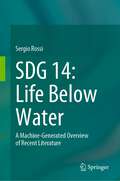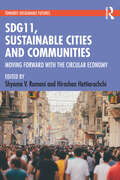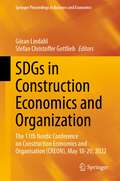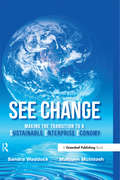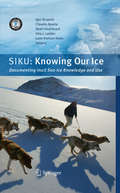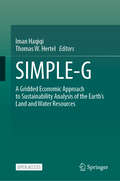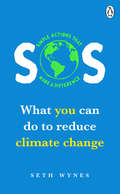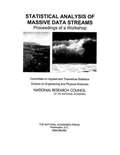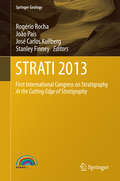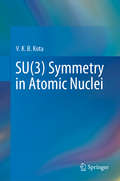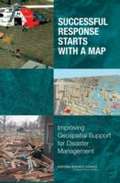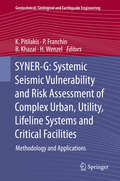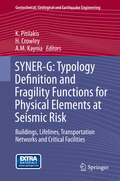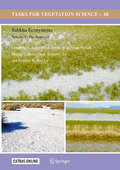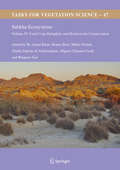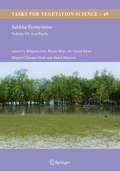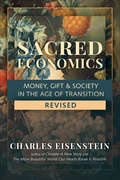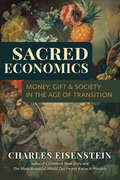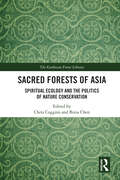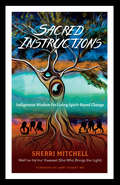- Table View
- List View
SDG 14: A Machine-Generated Overview of Recent Literature
by Sergio RossiThis book focuses, in seven chapters, on the perspectives and solutions that different research groups offer to try to address problems related to SDG 14: Life Below Water. The different objectives developed in SDG 14 are treated independently, with an attempt to give a global vision of the issues. The mechanism used to select the book's content was through an Artificial Intelligence program, choosing articles related to the topics by means of keywords. The program selected those articles, and those that were not related to the topic or did not focus on SDG 14 were discarded by a subject matter expert. Obviously, the selection was partial and the entire subject is not covered, but the final product gives a very solid idea of how to orient ourselves to delve deeper into the topic of SDG 14 using published chapters and articles. The AI program itself selected the text of these contributions to show the progress in different topics related to SDG 14. This mode of operation will allow specialists (and non-specialists) to collect useful information for their specific research purposes in a short period of time. At a time when information is essential in order to move quickly by providing concrete answers to complex problems, this type of approach will become essential for researchers, especially for a subject as vast as SDG 14.
SDG11, Sustainable Cities and Communities (Towards Sustainable Futures)
by Hiroshan Hettiarachchi Shyama V. RamaniThis book explores Sustainable Development Goal (SDG) 11, providing insights into viable pathways and policy designs for a transition towards sustainable, inclusive and resilient cities. The volume discusses existing scientific literature on SDG 11 and provides conceptual frameworks relating to systemic transitions, sectoral transitions and behavioural transitions for overcoming challenges related to governance and implementation. Through detailed case studies from cities and settlements, in Europe, Middle East and Asia, it showcases the dynamic processes involved in urban transformations. Drawing from these comparative analyses, the book provides robust frameworks and tools for better solutions and viable pathways to achieve SDG targets in diverse urban settings. Rich in empirical data, this book will be useful for scholars and researchers of development studies, environment studies, urban studies, urban sociology, political economy, political studies, public policy and sociology. It will also be useful for policy makers, professionals, non-governmental organisations (NGOs) and think tanks working in the area of sustainable development and urban planning.
SDGs in Construction Economics and Organization: The 11th Nordic Conference on Construction Economics and Organisation (CREON), May 18-20, 2022 (Springer Proceedings in Business and Economics)
by Göran Lindahl Stefan Christoffer GottliebThis book examines how research in construction economics and organization contributes to the achievement of the SDGs. Featuring selected contributions from the 11th Nordic Conference on Construction Economics and Organisation (CREON 2022) held in Copenhagen, Demark and Malmö, Sweden, the contributions of this book explore the ways in which research in construction economics and organization assists in building resilient infrastructure, fostering green innovations and contributes to sustainable economic growth. Each contribution relates to one or more individual SDG and describes how the research contributes to the understanding of construction management and economics.
SEDIMENT ROUTING SYSTEMS: The Fate of Sediment from Source to Sink
by Philip A. AllenThis cutting-edge summary combines ideas from several sub-disciplines including geology, geomorphology, oceanography and geochemistry to provide an integrated view of Earth surface dynamics in terms of sediment generation, transport and deposition. Introducing a global view of fundamental concepts underpinning source-to-sink studies, it provides an analysis of the component segments which make up sediment routing systems. The functioning of sediment routing systems is illustrated through calculations of denudation and sedimentation as well as the response to external drivers; with the final sections focusing on the stratigraphic record of sediment routing systems. Containing quantitative solutions to a wide range of problems in Earth surface dynamics, it is suitable for graduate students as well as academic and professional researchers; and will enable an understanding of sediment routing systems.
SEE Change: Making the Transition to a Sustainable Enterprise Economy
by Sandra Waddock Malcolm McIntoshThe return to business-as-usual after the economic earthquake that rocked financial markets, wrecked banks and brought to light the grotesque distortions of casino capitalism on people and planet must be resisted. A new form of capitalism is both necessary and possible as some forward-thinking political, business and civil society leaders have now recognised. This book is about the myriad problems that we face and the systemic changes that are necessary for all enterprises in whatever sector and however constituted to operate within sustainable limits, to lower their ecological footprint, to enhance social equity, and to develop a sense of futurity. Waddock and McIntosh argue that enterprise, innovation and creativity, like conversation, caring and sharing, are part of what it means to be human. They argue that we need to redefine our relationship with commerce to reconcile our relationship with the Earth. The authors see the seeds of economic change in new and fundamentally different forms – in entrepreneurship, networks, governance, transparency and accountability – already being planted and beginning to grow. To nurture these developments, they believe that we need to learn to "see" in new ways to begin to recognise their worth and to create a sufficiently broad, coherent and integrated social movement for change that can overcome the momentum of the current system. Incremental change – CSR, for example – will not be enough. Deep change is needed in the purposing, goals and practice of business enterprise. Deep change is needed in the ways that we, as humans, relate to nature and natural systems under severe stress from resource overuse and depletion, a quadrupled population during the 20th century, and human impact on climate. And deep change is needed in the ways in which we relate to each other, use our time and build our communities. This book documents some of the changes that are already in progress and provides optimism that a sustainable enterprise economy geared to innovation, creativity, problem-solving, entrepreneurialism and enthusiasm for life can produce wealth, preserve the natural environment and nurture social capital.
SIKU: Knowing Our Ice
by Igor Krupnik Claudio Aporta Gita J. Laidler Lene Kielsen Holm Shari GearheardBy exploring indigenous people's knowledge and use of sea ice, the SIKU project has demonstrated the power of multiple perspectives and introduced a new field of interdisciplinary research, the study of social (socio-cultural) aspects of the natural world, or what we call the social life of sea ice. It incorporates local terminologies and classifications, place names, personal stories, teachings, safety rules, historic narratives, and explanations of the empirical and spiritual connections that people create with the natural world. In opening the social life of sea ice and the value of indigenous perspectives we make a novel contribution to IPY, to science, and to the public
SIMPLE-G: A Gridded Economic Approach to Sustainability Analysis of the Earth’s Land and Water Resources
by Thomas W. Hertel Iman HaqiqiThis is an open access book. Crafted for both the economist and the curious mind, this book introduces a novel approach to blending economic and biophysical sciences to enable multi-scale analysis of a range of sustainability challenges confronting the world’s land and water resources at both local and global scales. It focuses specifically on the interface between the environment and food systems, utilizing economic theory to structure the overall framework. However, within the SIMPLE-G framework, there is ample room to incorporate fine-scale biophysical knowledge from agronomy, climate science, ecology, geography, hydrology, as well as a range of socioeconomic considerations. This enables multi-scale analyses incorporating grid cells that can vary in size from 250 meters to sub-regional scales. This, in turn, allows for investigation of global change drivers’ impacts on local sustainability, as well as feedbacks from local sustainability policies to regional and global outcomes. The book opens with a foreword by a prominent sustainability scientist, Prof. Navin Ramankutty, and proceeds in five parts covering, respectively: (1) introduction and overview, (2) basic economic theory underpinning SIMPLE-G, (3) the SIMPLE-G framework, including structure, data, parameters, computer implementation, and validation, (4) eight diverse applications of the SIMPLE-G framework, covering a range of geographies and sustainability challenges, and (5) a forward-looking chapter on future directions. The book provides step-by-step guidance on building and utilizing gridded models with real-world case studies demonstrating practical applications which will facilitate its use by academics, practitioners, and students conducting research on climate impacts, land-use, water resource management, food security, poverty, equity, nutritional outcomes, and overall sustainability.
SOS: What you can do to reduce climate change – simple actions that make a difference
by Seth Wynes'The most effective ways for individuals to reduce their carbon footprint' INewsClimate Change researcher, Seth Wynes, sets out in the simplest terms how you can make a real and positive impact.Make changes at home, at work, to how you shop, eat, live - start by finding one thing your family can change with this book and do it today. What you do matters - and the science proves it. How many actions can you tick of the list in this book to help save our planet?
STATISTICAL ANALYSIS OF MASSIVE DATA STREAMS: Proceedings of a Workshop
by Committee on Applied Theoretical StatisticsMassive data streams—large quantities of data that arrive continuously—are becoming increasingly commonplace in many areas of science and technology. Consequently development of analytical methods for such streams is of growing importance. To address this issue, the National Security Agency asked the NRC to hold a workshop to explore methods for analysis of streams of data so as to stimulate progress in the field. This report presents the results of that workshop. It provides presentations that focused on five different research areas where massive data streams are present: atmospheric and meteorological data; high-energy physics; integrated data systems; network traffic; and mining commercial data streams. The goals of the report are to improve communication among researchers in the field and to increase relevant statistical science activity.
STRATI 2013: First International Congress on Stratigraphy At the Cutting Edge of Stratigraphy (Springer Geology)
by João Pais Rogério Rocha José Carlos Kullberg Stanley FinneyThe 1st International Congress on Stratigraphy (STRATI 2013), hold in Lisbon, 1–7 July 2013, follows the decision to internationalize the conferences previously organized by the French Committee of Stratigraphy (STRATI), the last one of which was held in Paris in 2010. Thus, the congress possesses both the momentum gained from an established conference event and the excitement of being the first International Congress on Stratigraphy. It is held under the auspices of the International Commission on Stratigraphy (IUGS) and it is envisaged that this first congress will lead to others being held in the future.This book includes all papers accepted for oral or poster presentation at the 1st International Congress on Stratigraphy. Papers include a short abstract, main text, figures, tables and references. Each paper has been reviewed by two internationally renowned scientists.
STROMATOLITES: Interaction of Microbes with Sediments
by Joseph Seckbach Vinod TewariSTROMATOLITES: Interaction of Microbes with Sediments provides an overview and latest information about the formation of Stromatolites as a result of interaction of microbes with sediments. Eighty-three expert scientists from twenty-seven countries present the chapters in this volume which have been reviewed by thirty four referees. The volume deals with ancient to modern examples of stromatolites and microorganisms which are observed in various diverse environments, such as: marine, nonmarine, lacustrine and extreme geographical areas covering almost the whole earth. The reviews are original articles written by leading experienced experts, some chapters deal with latest instrumental techniques used for the study of microbes and Stromatolites. Other chapters have been contributed by young researchers who revealed updated data on Stromatolites. The astrobiological implications of early microbiota, sulfur isotopic ratios, microbialites in extreme conditions on earth has opened up new vistas in the search of extraterrestrial life.
SU(3) Symmetry in Atomic Nuclei
by V. K. KotaThis book provides an understandable review of SU(3) representations, SU(3) Wigner–Racah algebra and the SU(3) ⊃ SO(3) integrity basis operators, which are often considered to be difficult and are avoided by most nuclear physicists. Explaining group algebras that apply to specific physical systems and discussing their physical applications, the book is a useful resource for researchers in nuclear physics. At the same time it helps experimentalists to interpret data on rotational nuclei by using SU(3) symmetry that appears in a variety of nuclear models, such as the shell model, pseudo-SU(3) model, proxy-SU(3) model, symplectic Sp(6, R) model, various interacting boson models, various interacting boson–fermion models, and cluster models. In addition to presenting the results from all these models, the book also describes a variety of statistical results that follow from the SU(3) symmetry.
SUCCESSFUL RESPONSE STARTS WITH A MAP: Improving Geospatial Support for Disaster Management
by National Research Council of the National AcademiesIn the past few years the United States has experienced a series of disasters, such as Hurricane Katrina in 2005, which have severely taxed and in many cases overwhelmed responding agencies. In all aspects of emergency management, geospatial data and tools have the potential to help save lives, limit damage, and reduce the costs of dealing with emergencies. Great strides have been made in the past four decades in the development of geospatial data and tools that describe locations of objects on the Earth’s surface and make it possible for anyone with access to the Internet to witness the magnitude of a disaster. However, the effectiveness of any technology is as much about the human systems in which it is embedded as about the technology itself. This report assesses the status of the use of geospatial data, tools, and infrastructure in disaster management, and recommends ways to increase and improve their use. It explores emergency planning and response; how geospatial data and tools are currently being used in this field; the current policies that govern their use; various issues related to data accessibility and security; training; and funding. The report recommends significant investments be made in training of personnel, coordination among agencies, sharing of data and tools, planning and preparedness, and the tools themselves.
SYNER-G: Systemic Seismic Vulnerability and Risk Assessment of Complex Urban, Utility, Lifeline Systems and Critical Facilities
by K. Pitilakis P. Franchin B. Khazai H. WenzelSYNER-G, a multidisciplinary effort funded by the European Union, allowed the development of an innovative methodological framework for the assessment of physical as well as socio-economic seismic vulnerability and risk at urban and regional level. The results of SYNER-G are presented in two books both published by Springer, the present and a second one, entitled "SYNER-G: Typology Definition and Fragility Functions for Physical Elements at Seismic Risk: Buildings, Lifelines, Transportation Networks and Critical Facilities"(*), which provides a comprehensive state-of-the-art of the fragility curves, an alternative way to express physical vulnerability of elements at risk. In this second volume of SYNER-G, the focus has been on presenting a unified holistic methodology for assessing vulnerability at systems level considering interactions between elements at risk (physical and non-physical) and between different systems. The proposed methodology and tool encompasses in an integrated fashion all aspects in the chain, from hazard to the vulnerability assessment of components and systems and to the socio-economic impacts of an earthquake, accounting for most relevant uncertainties within an efficient quantitative simulation scheme. It systematically integrates the most advanced fragility functions to assess the vulnerability of physical assets for buildings, utility systems, transportation networks and complex infrastructures such as harbours and hospitals. The increasing impact due to interactions between different components and systems is treated in a comprehensive way, providing specifications for each network and infrastructure. The proposed socio-economic model integrates social vulnerability into the physical systems modelling approaches providing to decision makers with a dynamic platform to capture post disaster emergency issues like shelter demand and health impact decisions Application examples at city and regional scale have provided the necessary validation of the methodology and are also included in the book. The present volume, with its companion volume on fragility functions, represent a significant step forward in the seismic vulnerability and risk assessment of complex interacting urban and regional systems and infrastructures. These volumes are not only of interest to scientists and engineers but also to the insurance industry, decision makers and practitioners in the sector of civil protection and seismic risk management. (*) Pitilakis K, Crowley E, Kaynia A (eds) (2014) SYNER-G: Typology definition and fragility functions for physical elements at seismic risk, Series: Geotechnical, Geological and Earthquake Engineering 27, ISBN 978-94-007-7872-6, Springer Science+Business Media, Dordrecht.
SYNER-G: Typology Definition and Fragility Functions for Physical Elements at Seismic Risk
by K. Pitilakis H. Crowley A. M. KayniaFragility functions constitute an emerging tool for the probabilistic seismic risk assessment of buildings, infrastructures and lifeline systems. The work presented in this book is a partial product of a European Union funded research project SYNER-G (FP7 Theme 6: Environment) where existing knowledge has been reviewed in order to extract the most appropriate fragility functions for the vulnerability analysis and loss estimation of the majority of structures and civil works exposed to earthquake hazard. Results of other relevant European projects and international initiatives are also incorporated in the book. In several cases new fragility and vulnerability functions have been developed in order to better represent the specific characteristics of European elements at risk. Several European and non-European institutes and Universities collaborated efficiently to capitalize upon existing knowledge. State-of-the-art methods are described, existing fragility curves are reviewed and, where necessary, new ones are proposed for buildings, lifelines, transportation infrastructures as well as for utilities and critical facilities. Taxonomy and typology definitions are synthesized and the treatment of related uncertainties is discussed. A fragility function manager tool and fragility functions in electronic form are provided on extras. springer. com. Audience The book aims to be a standard reference on the fragility functions to be used for the seismic vulnerability and probabilistic risk assessment of the most important elements at risk. It is of particular interest to earthquake engineers, scientists and researchers working in the field of earthquake risk assessment, as well as the insurance industry, civil protection and emergency management agencies.
Sabkha Ecosystems Volume V: The Americas
by Siegmar-W. Breckle Miguel Clüsener-Godt M. Ajmal Ajmal Khan Benno Boër Münir Ȫzturk Bilquees GulThis book is a part of the Sabkha Ecosystems series which was designed to provide information on sabkha ecosystems of different regions and to add to the collective knowledge available about saline ecosystems. The comprehensive coverage assists the reader gaining a thorough understanding of sabkha geology, hydrology, geomorphology, zoology, botany, ecology and ecosystem functioning, as well as sabkha conservation, utilization and development. Volume I focused on The Arabian Peninsula and Adjacent Countries, volume II was based on describing saline ecosystems of West and Central Asia , volume III referred to Africa and Southern Europe, while volume IV focused on Cash Crop Halophyte and Biodiversity Conservation. The present volume V focuses on Americans.
Sabkha Ecosystems: Cash Crop Halophyte and Biodiversity Conservation
by Münir Öztürk Benno Böer M. Ajmal Khan Miguel Clüsener-Godt Bilquees Gul Thabit Zahran AbdessalaamSustainable development is the key for the survival in 21st century. The natural resources are finite and cannot be used with impunity because we are the custodian of these resources and have responsibility to pass these to the next generation. This monumental task requires several major commitments and most important of them is to arrest population explosion which has already reached seven billion. Natural resources like air to breath, food to eat, and water to drink, and fossil fuel to maintain this life style are being overexploited. Unrestrained consuming culture will accelerate undesired situation. This situation will have more dire consequences in resource limited ecosystems like dry lands. Given the severe scarcity of water, ever increasing population and soil salinization out of the box solutions for the provision of food and clean energy is required to spare meager fresh water resources for conventional agriculture. This volume contains a number of articles dealing with halophyte ecology, bio-geography, ecophysiology, hyper-saline soils, biofuels, biosaline agriculture, biosaline landscaping, climate change mitigation, and biodiversity. It also contains the communication of innovative ideas, such as the research into floating mangroves, seagrass terraces, as well as a World Halophyte Garden containing all known salt-tolerant plant species. It is hoped that the information provided will not only advance vegetation science, but that it will truly generate more interdisciplinarity, networking, awareness, and inspire farmers, and agricultural and landscaping stakeholders to seriously engage in halophyte cash crop production in coastal hyper-saline areas.
Sabkha Ecosystems: Volume VI: Asia/Pacific (Tasks for Vegetation Science #49)
by Benno Böer M. Ajmal Khan Miguel Clüsener-Godt Bilquees Gul Abdul HameedThis book is the sixth and final volume in the Tasks for Vegetation Science book series, and it concludes the most comprehensive scientific documentation dealing with hypersaline ecosystems of the world.
Sacred Economics, Revised: Money, Gift & Society in the Age of Transition
by Charles EisensteinExpanded and updated, Charles Eisenstein's classic treatise on capitalism, currency, and the gift economy.This revised version traces the history of money, from ancient gift economies to modern capitalism, and includes new material on cryptocurrencies and emerging research that has come out since the book's original publication. CharlesEisenstein shows how capitalism contributes to alienation, competition, and scarcity; destroys community; and necessitates endless growth at the cost of social and environmental devastation. Today, these trends have reached their extreme--and their collapse presents a golden opportunity to transition to a more connected, ecological, and sustainable way of being.Eisenstein describes the deeper narratives beneath our economic system, and how we can reimagine it to align with a new story. Applying a broadly integrated synthesis of theory, policy, and practice, he explores avant-garde concepts of the New Economics, including negative-interest currencies, local economies, gift economics, cryptocurrencies, and the restoration of the commons. Tapping into a rich lineage of conventional and unconventional economic thought, Eisenstein presents a vision that is original yet commonsense, radical yet gentle, and increasingly relevant as the crises of our civilization deepen.
Sacred Economics: Money, Gift, and Society in the Age of Transition
by Charles EisensteinSacred Economics traces the history of money from ancient gift economies to modern capitalism, revealing how the money system has contributed to alienation, competition, and scarcity, destroyed community, and necessitated endless growth. Today, these trends have reached their extreme--but in the wake of their collapse, we may find great opportunity to transition to a more connected, ecological, and sustainable way of being. This book is about how the money system will have to change--and is already changing--to embody this transition. A broadly integrated synthesis of theory, policy, and practice, Sacred Economics explores avant-garde concepts of the New Economics, including negative-interest currencies, local currencies, resource-based economics, gift economies, and the restoration of the commons. Author Charles Eisenstein also considers the personal dimensions of this transition, speaking to those concerned with "right livelihood" and how to live according to their ideals in a world seemingly ruled by money. Tapping into a rich lineage of conventional and unconventional economic thought, Sacred Economics presents a vision that is original yet commonsense, radical yet gentle, and increasingly relevant as the crises of our civilization deepen.About the Imprint: EVOLVER EDITIONS promotes a new counterculture that recognizes humanity's visionary potential and takes tangible, pragmatic steps to realize it. EVOLVER EDITIONS explores the dynamics of personal, collective, and global change from a wide range of perspectives. EVOLVER EDITIONS is an imprint of North Atlantic Books and is produced in collaboration with Evolver, LLC.From the Trade Paperback edition.
Sacred Forests of Asia: Spiritual Ecology and the Politics of Nature Conservation (The Earthscan Forest Library)
by Chris Coggins Bixia ChenPresenting a thorough examination of the sacred forests of Asia, this volume engages with dynamic new scholarly dialogues on the nature of sacred space, place, landscape, and ecology in the context of the sharply contested ideas of the Anthropocene. Given the vast geographic range of sacred groves in Asia, this volume discusses the diversity of associated cosmologies, ecologies, traditional local resource management practices, and environmental governance systems developed during the pre-colonial, colonial, and post-colonial periods. Adopting theoretical perspectives from political ecology, the book views ecology and polity as constitutive elements interacting within local, regional, and global networks. Readers will find the very first systematic comparative analysis of sacred forests that include the karchall mabhuy of the Katu people of Central Vietnam, the leuweng kolot of the Baduy people of West Java, the fengshui forests of southern China, the groves to the goddess Sarna Mata worshiped by the Oraon people of Jharkhand India, the mauelsoop and bibosoop of Korea, and many more. Comprising in-depth, field-based case studies, each chapter shows how the forest’s sacrality must not be conceptually delinked from its roles in common property regimes, resource security, spiritual matters of ultimate concern, and cultural identity. This volume will be of great interest to students and scholars of indigenous studies, environmental anthropology, political ecology, geography, religion and heritage, nature conservation, environmental protection, and Asian studies.
Sacred Instructions: Indigenous Wisdom for Living Spirit-Based Change
by Larry Dossey Sherri MitchellA narrative of Indigenous wisdom that provides a road map for the spirit and a compass of compassion for humanity Drawing from ancestral knowledge, as well as her experience as an attorney and activist, Sherri Mitchell addresses some of the most crucial issues of our day, such as environmental protection and human rights. Sharing the gifts she has received from elders around the world, Mitchell urges us to decolonize our language and our stories. For those seeking change, this book offers a set of cultural values that will preserve our collective survival for future generations.
Sacred Mountain: Everest
by Christine Taylor-ButlerA photo-essay exploring the cultural, geological, and ecological history of Mount Everest, focusing on the indigenous Sherpa and their spiritual connection to the mountain, record-setting climbing expeditions, and the effects of tourism on the environment.Mount Everest--a place of mystery, majesty, and unparalleled beauty--rises into the sky higher than any other mountain on Earth. Many stories have been told about the dangers and triumphs of climbing to the summit; but few have been written about the Sherpa, the people who have lived on the mountain for centuries and consider it sacred. Known for their bravery, strength, and skill in navigating the mountain's treacherous slopes, Sherpas have played a crucial role in Mount Everest's exploration since the 1920s. In recent years, however, increasing tourism has threatened the mountain's fragile ecosystem. The Sherpa now face the challenge of restoring and protecting this sacred mountain for their future and for the world. With stunning photographs and engaging text, Scared Mountain presents a unique picture of Mount Everest--its history, its ecology, and especially its people--that will captivate readers of all ages.
